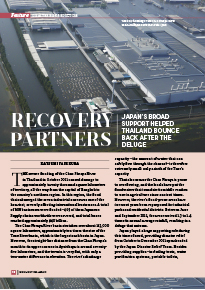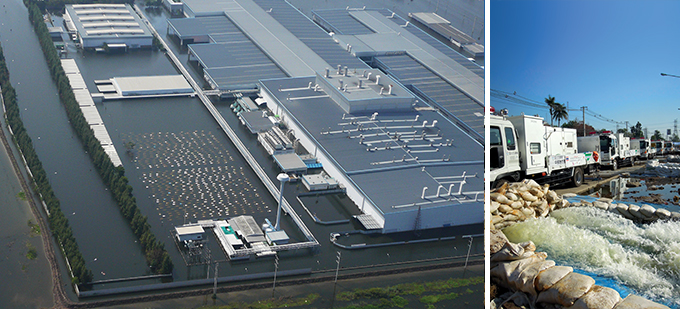Home > Highlighting JAPAN >Highlighting Japan March 2015>Disaster Risk Reduction
Highlighting JAPAN

Disaster Risk Reduction
Recovery Partners
Japan’s broad support helped
Thailand bounce back after the deluge

The severe flooding of the Chao Phraya River in Thailand in October 2011 caused damage to approximately twenty thousand square kilometers of territory, all the way from the capital of Bangkok to the country’s northern region. In this region, the flood that submerged the seven industrial zones was one of the heaviest, severely affecting international businesses. A total of 808 businesses were flooded—469 of them Japanese. Supply chains worldwide were severed, and total losses reached approximately $40 billion.
The Chao Phraya River basin stretches over about 163,000 square kilometers, approximately ten times the size of the Tone River basin, which is the largest such basin in Japan. However, the straight-line distance from the Chao Phraya’s mouth to its upper courses in Ayutthaya is around seventy-five kilometers, and the terrain is very flat, with only a two-meter difference in elevation. The river’s discharge capacity—the amount of water that can safely flow through the channel—is therefore extremely small: only a sixth of the Tone’s capacity.
That also means the Chao Phraya is prone to overflowing, and the locals have put the floodwaters that inundate its middle reaches to use in agriculture since ancient times. However, the river’s flood-prone areas have in recent years been repurposed for industrial parks and residential districts. Between June and September 2011, the area received 1.3 to 1.4 times its annual average rainfall, resulting in a deluge that autumn.
Japan played a huge supporting role during this time of need, providing disaster relief from October to December 2011 spearheaded by the Japan Disaster Relief Team. Besides providing supplies—including tents, water purification systems, portable toilets, life jackets, insecticides and a quarter of a million sandbags—Japan sent flood disaster assessment teams to waterworks, subways and airports, as well as healthcare research teams to protect against infectious diseases and other health hazards.
The most attention-getting aspect of the initial relief efforts was the headway made with ten drainage pump cars from Japan’s Ministry of Land, Infrastructure, Transport, and Tourism, dispatched abroad for the first time. Fifty-one personnel sent from the Japanese government stayed for two months, working round the clock. Including onsite staff, 880 people were involved in the effort each day, and in the first thirty-two days drained approximately 8.1 million cubic meters of water. After December, efforts refocused on support for flood control plans, such as creating precision topographic maps with aerial laser measurements and enacting flood disaster prevention policies. This included controlled inundation in upper and middle courses to protect important areas downstream. The world’s first flood forecasting system that can predict flood areas a week in advance was also developed, and through grant assistance totaling more than ten billion yen, critical roads were raised several meters above sea level and floodgates were installed at vital thoroughfares.
The above support capitalizes on the world-class technological and economic power of Japan, as well as the experience it has built up in the course of the many disasters the nation has survived. Special mention was also made of JICA senior advisor Kimio Takeya, a member of the water resource management strategy committee chaired by Thailand’s prime minister and deputy prime minister, who helped the Thai government create national policies and a reconstruction roadmap. Takeya was the only foreign advisor whose presence Thailand’s prime minister directly requested for the relief effort.
“JICA actually conducted a development study of the Chao Phraya in 1999, and proposed a flood control master plan,” Takeya reports. “Unfortunately, the Thai government chose to invest in economic infrastructure like roads, railways and airports rather than flood prevention. We therefore decided in November to review the 1999 master plan to adjust to recent changes in the river basin, and I was invited to the Strategic Committee for Water Resource Management. By the king’s edict, the committee succeeded in securing a budget of approximately 350 billion baht, and was directly involved in deciding the general flood control measure framework. I think those were big accomplishments.”
As illustrated by the Thai floods, disaster prevention is an essential piece of infrastructure that safeguards the development of the global economy. If Japan can secure a place for disaster risk reduction on the post-2015 development agenda, its global presence in the area is bound to expand.
© 2009 Cabinet Office, Government of Japan






